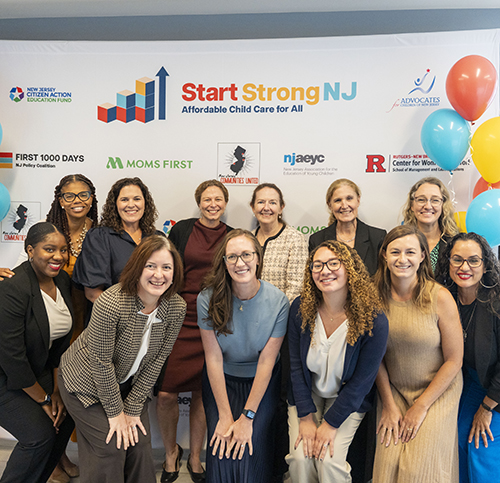Posted on August 20, 2025
What’s New?
An Underfunded Division of Family Development Threatens New Jersey’s Child Care System, Families and the Economy
Posted on April 14, 2025
NEWS RELEASE: NJ Kids Count Data Highlights What’s at Stake for Children with Looming Cuts to Medicaid and Other Essential Services
Posted on April 23, 2025
CONTACT:
Lana Lee
llee@acnj.org
973-643-3876
NEWARK, NJ – With nearly 860,000 children receiving health insurance through NJ FamilyCare, roughly 401,000 students relying on free or reduced-price school lunch, and close to 360,000 children accessing food assistance through SNAP, looming federal cuts to Medicaid and other essential services would devastate federal programs that support the healthy development of our children, according to Advocates for Children of New Jersey.
Its annual data publication, NJ Kids Count 2025: The State of Our Counties, provides a comprehensive snapshot of how well children are faring in the Garden State, underscoring the impact of federal investments on children and families in meeting their basic needs. The data report provides 63 measures of child well-being across 21 counties in the following areas: demographics, family economic security, child health, child protection, child care, education, and teens.
“Without a doubt, if enacted, these deep federal budget cuts will affect you and someone you know. This includes 1.8 million New Jerseyans who rely on NJ FamilyCare, the state’s publicly-funded health insurance program financed through federal and state Medicaid dollars. Slashing Medicaid will have lifelong consequences for New Jersey’s children and youth, denying them of life-saving care and essential services like well-child visits, immunizations, as well as treatments for chronic ailments such as asthma and dental services,” said Mary Coogan, ACNJ President and CEO.
“Advocates for Children of New Jersey has been a longtime champion of NJ FamilyCare, which now covers nearly 20% of all residents living in the Garden State. Medicaid also covers about a third of all New Jersey births annually. These budget decisions will reverberate not just throughout our healthcare system, but will have a ripple effect on our economy, our education and our future,” Coogan added.
Medicaid funding represents a significant portion of state budgets, with New Jersey alone receiving $14 billion in federal Medicaid dollars. As the state legislature and governor work to finalize the state budget, any potential cuts in federal funding will have direct and substantial implications for New Jersey's fiscal decisions.
“This is a pivotal moment to ensure children's needs are prioritized. With the gubernatorial and general assembly elections approaching this November, and the state budget deadline of June 30 looming, ACNJ's #NJVotes4Kids campaign is encouraging voters to engage with all candidates. Whether attending a town hall or community event, your advocacy matters. Together, we can ensure that New Jersey's children aren't just part of the conversation—they're at the very center of our lawmakers' priorities," Coogan said.
Numbers at a Glance
Demographics
- New Jersey is home to over two million children, and every one in four is under the age of 5.
- Essex County has the largest child population with 198,853 children under 18 years of age, followed closely by Bergen County at 198,334.
- In five counties, more than 40% of children speak a language other than English at home: Bergen (42%), Hudson (57%), Middlesex (47%), Passaic (50%), and Union (47%).
Family Economic Security
- Roughly 13% of New Jersey children live below the federal poverty level, which in 2023 was $30,900 for a family of four (2 adults and 2 children).
- New Jersey’s median family income with children is $126,827. Morris and Somerset have the greatest estimated median family income with children of more than $185,000, in steep contrast to Cumberland’s median family income of roughly $62,000.
- The state unemployment rate was 4.4% in 2023.
- An estimated 263,260 children in New Jersey were estimated to be food insecure in 2022.
- In 2024, 20,466 children lived in families receiving Temporary Assistance for Needy Families (TANF), more commonly referred to as welfare. The program provides cash assistance to needy families through a federally funded block grant given to individual states.
- In October 2024, of the students participating in free or reduced-price lunch, 57% were also participating in free or reduced-price breakfast. More than half of the counties in the state have rates below that of New Jersey.
Child Health
- In 2022, 73% of expectant mothers received early prenatal care, a 2% decrease from the previous year.
- The infant mortality rate–the rate at which a baby dies before their first birthday–was 4.0 for every 1,000 live births from 2017 through 2021. Data disaggregated by race shows the infant mortality rate for Black babies to be more than double at 8.7 per 1,000 births.
- The number of NJ FamilyCare recipients under age 19 declined by 8% between 2023 and 2024.
- Of the 824 dental practices listed in 0-6 year old MCO directories, only 49% had accurate information on practices that provide dental care for 2-year-olds and only 63% had accurate insurance network information.
Child Protection
- In 2024, only 2% of the 94,801 children reported to the state child abuse hotline were found to be substantiated or established cases of abuse/neglect.
- Of the nearly 3,000 children living in foster care, there remains an over-representation of Black children in out-of-home placements at 43% compared to Hispanic and White children at 26% and 24%, respectively.
Child Care
- In 2024, New Jersey had 4,092 licensed child care centers, with the largest number of centers located in Bergen (440) and Essex (480).
- The number of registered family child care providers–those who care for children in their own homes–increased 14% between 2021 and 2024 with 1,362 statewide. Middlesex County saw the highest jump from 81 providers in 2021 to 153 in 2024.
Education
- During the 2023-24 school year, 60,365 3- and 4-year-olds were enrolled in state-funded public preschool.
- In 2023-24, 1 in 10 of New Jersey’s pre-K-12 students was considered to be a multilingual learner–a student whose primary language is other than English and does not have English language proficiency in listening, speaking and writing.
- Between 2019-2023, about 43% of the state population ages 25 and older had a bachelor’s degree or higher. The counties where more than half of the population ages 25 and older had a bachelor’s degree or higher are Somerset (57%), Morris (57%), Hunterdon (56%), Bergen (53%), and Monmouth (51%).
- For the 2023-24 school year, the percentage of third graders meeting or exceeding expectations on the New Jersey Student Learning Assessments was 44% for English Language Arts and 48% for Mathematics. A closer look at the data shows wide disparities in proficiency among counties, ranging from a high of 59% (Morris) and 58% (Bergen) to a low of 21% (Cumberland) and 29% (Atlantic) in English Language Arts.
- For the 2023-24 school year, the percentage of eighth graders meeting or exceeding expectations on the New Jersey Student Learning Assessments was 53% for English Language Arts and 19% for Mathematics.
Teens
- Births to adolescents and teens ages 10-19 remain at 2%. Cumberland had 7% of its total births to adolescents and teens.
- According to the 2019-2023 five-year American Community Survey (ACS) estimates, 5%, or 23,803, NJ teens ages 16-19 are neither working nor in school. Cumberland is estimated to have 14% of its teens not working nor in school.
###
ABOUT ADVOCATES FOR CHILDREN OF NEW JERSEY (ACNJ)
Advocates for Children of New Jersey is the trusted, independent voice putting children’s needs first for 45 years. Our work results in better laws and policies, more effective funding and stronger services for children and families. And it means that more children are given the chance to grow up safe, healthy, and educated. For more information, visit www.acnj.org.
New Jersey facing devastating federal funding cuts to critical programs that support children and families
Posted on April 2, 2025

Mary E. Coogan, Esq.
ACNJ President/CEO
On April 1st, five regional offices within the US Department of Health and Human Services (HHS) were closed, including 𝐑𝐞𝐠𝐢𝐨𝐧 𝟐 𝐰𝐡𝐢𝐜𝐡 𝐠𝐨𝐯𝐞𝐫𝐧𝐬 𝐍𝐞𝐰 𝐉𝐞𝐫𝐬𝐞𝐲. These offices support child care and Head Start programs, and child welfare services. All staff who worked in these regional offices were placed on leave effective immediately and no longer have access to their files or offices. No transition plan was shared with staff or programs. Rather, this abrupt change only served to increase anxiety and stress. A fact sheet on “HHS’ Transformation to Make American Healthy Again” did not provide much more detail. It is unclear how grants will be administered moving forward, including child care and Head Start grants due to start on 𝐌𝐚𝐲 𝟏. The other offices closed were Regions 1 (Boston), 5 (Chicago), 9 (San Francisco), and 10 (Seattle).
This action resulted from the US Department of Health and Human Services’ (HHS) effort to make the department “more responsive and efficient.” On March 27, HHS announced a “dramatic restructuring in accordance with President Trump's Executive Order: Implementing the President’s ‘Department of Government Efficiency’ Workforce Optimization Initiative.” The press release announced a significant staff reduction due to streamlining and centralizing core functions, consolidating divisions, and combining 10 regional offices into five.
At the same time, members of Congress are debating significant cuts to programs like Medicaid, the Supplemental Nutrition Assistance Program (SNAP), and other food programs like school meals. The federal Social Services Block Grant, which supports the work of our Department of Children and Families (DCF), may also be subjected to cuts. Any federal cuts to these programs will significantly impact New Jersey children and families.
Federal and state Medicaid dollars fund NJ FamilyCare, which provides health insurance to 1.8 million people in New Jersey, including 830,000 children, ages 0-18, from low- and moderate-income families and another 80,000 young people, ages 19-21. Medicaid covers almost one-third of the births in New Jersey annually and also covers long-term care for the seriously disabled and elderly. For many families, this coverage is temporary and invaluable during times of crisis. People furloughed or laid off can rely on NJ FamilyCare for coverage so medical bills do not drive them into debt.
In March, the House of Representatives passed a Budget Resolution seeking to cut $1.5 trillion over the next 10 years. To help achieve this goal, members of the House Energy and Commerce Committee, which oversees Medicare and Medicaid, were instructed to cut at least $880 billion from the budget. It is anticipated that most of the committee’s cuts will have to be from Medicaid.
Federal cuts to Medicaid will have a devastating impact on NJ FamilyCare, resulting in a potential loss of $10 billion, according to the Murphy Administration -- funding the state does not have. Several options are being considered, including significant changes to the Federal Medical Assistance Percentage (FMAP), which are the percentage rates used to determine the amount a state receives from the federal government for its Medicaid program. Others are recommending that the federal government shift more administrative costs to states, restrict or eliminate the use of provider taxes and directed payments to health care providers, or impose work reporting requirements that studies have shown are more likely to result in a loss of coverage for many low-income working Americans, resulting in a lack of needed health care or increase in unaffordable medical bills.
The FMAP is determined by a formula based upon a state’s per capita income. New Jersey currently benefits from a statutory 50 percent floor on matching funds for most Medicaid services. If this “floor” were eliminated, New Jersey’s match rate would be closer to 38 percent. The proposals being considered by Congress may result in a loss of $2.2 - $5.2 billion in federal funding to New Jersey.
The FMAP determines the match rate for other federal funding, including foster care, adoption, and kinship legal guardianship subsidies, and DCF prevention programs. Medicaid helps support services provided in schools for students with Individual Education Plans (IEPs). The NJ Children’s System of Care (CSOC) provides treatment and support services to over 38,000 children and youth with moderate to severe behavioral health problems and/or intellectual or developmental disabilities, including autism, each month. CSOC services are provided at no cost to families, relying on private health insurance, NJ FamilyCare, and state funds. DCF reports that 69% of children receiving services through CSOC are insured by Medicaid. A reduction in the federal match for Medicaid and the federal Children’s Health Insurance Program (CHIP) could create a $38.9 million budget gap for CSOC.
Finally, the House Agriculture Committee has been instructed to cut $230 billion, which could mean a significant reduction in funding for the Supplemental Nutrition Assistance Program (SNAP) and school meals. The continuing resolution currently funding the federal government through September has already cut $26 million in funding that supports New Jersey’s local food programs.
Join the Movement to Make Child Care a Top Priority for Our Next Governor
Posted on October 1, 2025
ACNJ leading the charge to Start Strong NJ, a campaign fighting for affordable child care for all.
Child care has reached a breaking point. Infant care averages nearly $20,000 a year. Preschool? Almost $19,000. For many families, child care costs more than their mortgage — and, here’s the striking part, more than the average cost of in-state college tuition.
But this isn’t just a family hardship. It’s an economic problem. When parents can’t afford reliable child care, they reduce hours, turn down promotions, or leave the workforce altogether. Employers lose talent. Businesses lose productivity. New Jersey loses growth.
ACNJ along with the New Jersey Association for the Educaiton of Young Children (NJAEYC) are leading the charge to Start Strong NJ, a campaign of the First 1,000 Days NJ Policy Coalition, bringing together business leaders, policymakers, providers, parents, and advocates committed to making affordable, high-quality child care available to every family in the state. The campaign’s policy agenda emphasizes affordability, a stable workforce, and lasting public investment to strengthen New Jersey’s economy and secure a strong future for children.
Here’s what else we know: If we want families to stay in New Jersey, grandparents to remain connected, and our workforce to thrive, we must treat child care as essential infrastructure.
After the November gubernatorial election, Start Strong NJ will present the new governor with a blueprint — a roadmap of actionable steps they can take in their first year. And this coalition will be the go-to resource for every question on early care and education in New Jersey.
New Jersey has a choice. We can continue patching a broken system with small fixes — or we can reimagine child care as the public good it truly is.
That means:
- Expanding access to the Child Care Assistance Program.
- Incentivizing employers to help cover the cost.
- Enhancing tax credits for families.
- Strengthening and expanding paid family leave.
- And making bold public investments so child care teachers earn professional wages.
So the question for New Jersey’s next governor isn’t “Can we afford to invest in child care?”
The question is: “Can we afford not to?”
Because if we want a stronger economy, stronger communities, and a stronger future for our children — then bold investment in our child care infrastructure must remain a top priority for the next administration.



